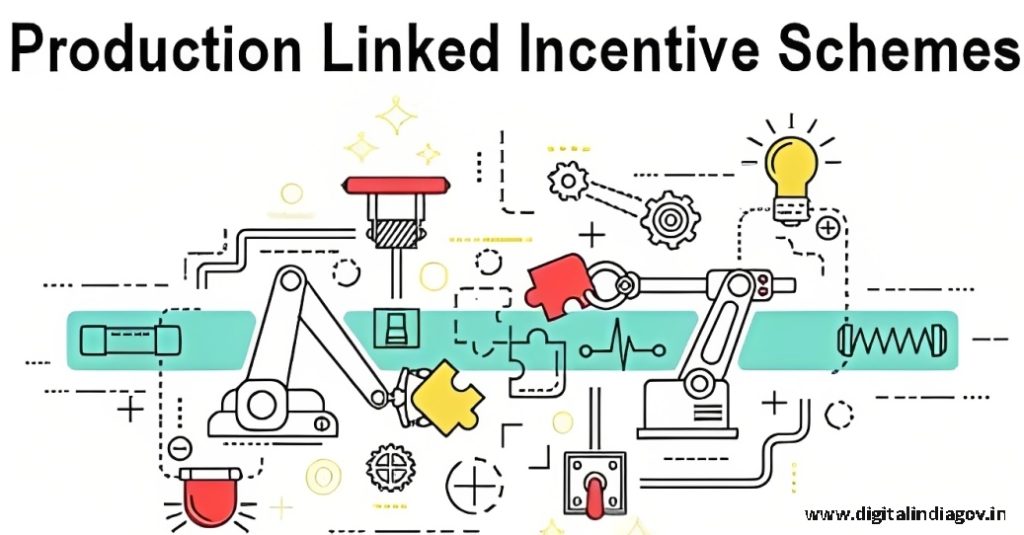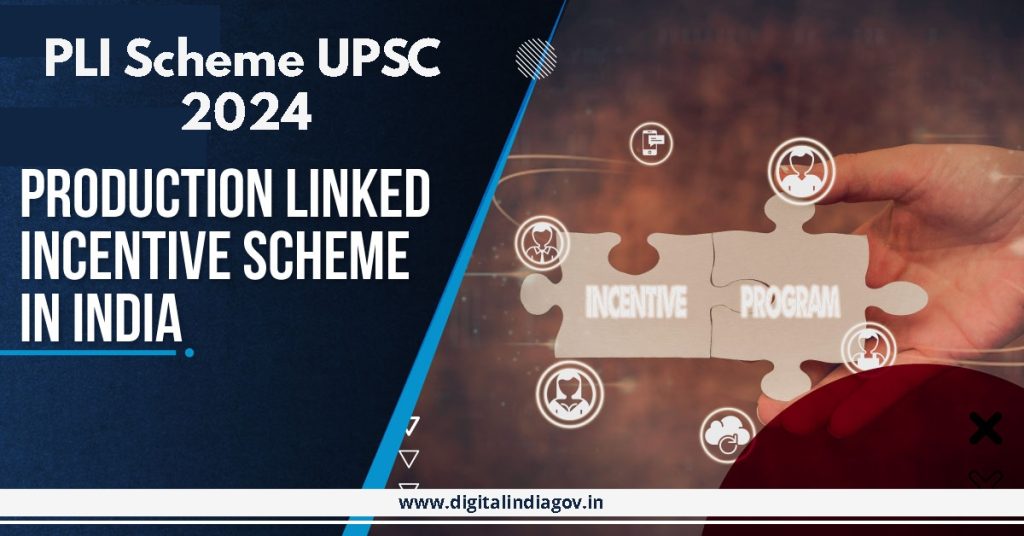PLI Scheme UPSC:- The purpose of the Production Linked Incentive, or PLI, plan is to provide enterprises with incentives based on incremental sales of products created domestically. The program encourages international businesses to establish units in India, but it also seeks to incentivize domestic businesses to establish new facilities or expand current ones, create jobs, and reduce India’s dependency on imports from other nations. Towards the end of 2020, it was extended to eleven other sectors after being initially proposed for the large-scale electronics Manufacturing industry in April. This program was introduced to support India’s Atmanirbhar Bharat initiative.
Visit the linked article to obtain the List of Significant Government Schemes in India. This article will go over the key industries where the Production Linked Incentive program has been implemented, as well as its goals and future directions. Additionally, this is a crucial subject in light of the impending IAS Exam.
Contents
PLI Scheme UPSC – A Brief Background
- The IT Ministry introduced it as a part of the National Policy on Electronics to provide incentives ranging from 4 to 6% to electronic enterprises that produce electronic components such as transistors, diodes, and mobile phones.
- This scheme’s primary goal was to entice foreign investors to establish manufacturing facilities in India while simultaneously encouraging domestic producers to grow and create jobs.
- The PLI plan began targeting the large-scale electronics manufacturing sector in April 2020. Ten other industries, including food processing, communications, electronics, textiles, specialty steel, automobiles and auto components, solar photovoltaic modules, and white goods like air conditioners and LEDs, were added to the PLI before the end of the year (November 2020).
- Regarding eligibility, any Indian or internationally recognized electronic manufacturing company with a registered office in India may apply for the program.
- Finance Minister Nirmala Sitharaman announced in the Union Budget 2021 that thirteen new sectors will be added to the PLI plan for a five-year term. Starting in the Financial Year 2022, Rs. 1.97 lakh crores will be provided for this plan.

Also Read:- Sovereign Gold Bond Scheme 2023-24
The objective of the PLI Scheme UPSC
Making domestic manufacturing globally competitive and producing global manufacturing champions are the scheme’s main goals. It’s critical to increase India’s compliance with World Trade Organization (WTO) obligations and to establish non-discriminatory, impartial policies regarding exports and domestic sales. The following are the scheme’s additional goals:
- Safeguard specific product segments.
- Implement non-tariff measures to increase the cost of imports
- Recognize the importance of exports in the broader growth strategy while placing more emphasis on the home market.
- Encourage capital investments and provide production incentives to boost domestic manufacturing.
- Draw in cutting-edge technologies and core expertise competencies.
- Assure efficiency and generate economies of scale.
- Encourage the creation of jobs and employment
- Establish export hubs at the district level.
- lessen the burden of compliance
- Boost business ease of doing business
- Reduce the cost of logistics
- Increase the production of domestic manufacturing in five years.
Expansion of PLI Scheme UPSC
- On November 11, 2020, the Union Cabinet, presided over by Prime Minister Narendra Modi, approved the launch of the PLI scheme for the ten important industries that can boost exports and strengthen India’s manufacturing capabilities.
- Along with the approved financial expenditure, the ten new sectors to which the project has been expanded are given below:
| Sectors | Implementing Ministry/Department | Approved financial outlay over a five-year period (Rs. in crores) |
| Advance ChemistryCell (ACC) Battery | NITI Aayog and Department of Heavy Industries | 18100 |
| Electronic/Technology Products | Ministry of Electronics and Information Technology | 5000 |
| Automobiles& Auto Components | Department of Heavy Industries | 57042 |
| Pharmaceuticals drugs | Department of Pharmaceuticals | 15000 |
| Telecom & Networking Products | Department of Telecom | 12195 |
| Textile Products: MMF segment and technical textiles | Ministry of Textiles | 10683 |
| Food Products | Ministry of Food Processing Industries | 10900 |
| High-Efficiency Solar PV Modules | Ministry of New and Renewable Energy | 4500 |
| White Goods (ACs & LED) | Department for Promotion of Industry and Internal Trade | 6238 |
| Speciality Steel | Ministry of Steel | 6322 |

Also Read:- PMEGP Scheme List 2024
The government has extended the Production Linked Incentive system to eleven industries, with the aim of achieving the following objectives:
- The administration wants to increase exports and integrate India into the world’s supply chain.
- India is predicted to have a $1 trillion digital economy by 2025 as a result of government initiatives like Smart City and Digital India, which are predicted to boost demand for electronics.
- The PLI program will improve the competitiveness of the Indian automobile industry and accelerate its globalization.
- Being the second-largest producer of steel in the world, India stands to gain from the introduction of steel under the PLI scheme. The country’s textile industry is among the largest in the world, and this scheme will draw significant investment in the sector to further boost domestic manufacturing, particularly in the manmade fiber (MMF) segment and technical textiles.
- In a similar vein, the introduction of telecom, solar energy, pharmaceuticals, white goods, and all the other industries can boost the nation’s economy and establish India as a global center for manufacturing.
Production Linked Incentive Scheme for Large-Scale Electronics Manufacturing
- To support the large-scale electronics manufacturing sector, the PLI scheme’s first phase aimed to increase mobile phone manufacturing in India as well as set up assembly, testing, marking, and packaging (ATMP) units.
- The entire anticipated cost of the scheme was INR 40,995 crore.
- Its main purpose upon establishment was to support the indigenous industries of India and a limited number of international investors.
- The program has the potential to create over 2 lakh jobs in the electronics manufacturing industry in only five years.
- As of current present, electronics are assembled in India after being made outside of the country. The Made in India initiative and PLI plan enable indigenous production and assembly of electronics.
- Between 2014 and 2015, the country’s mobile phone production amounted to approximately INR 18,900 crore, but by 2018–19, it had increased to INR 1,70,000 crore, nearly meeting all domestic demand. PLI can significantly increase this.
The table given below shows the financial outlay as per the first phase of the Production Linked Incentive (PLI) Scheme:
| Sectors | ImplementingMinistry/Department | Financial outlays(Rs. in crore) |
| Mobile Manufacturing and Specified Electronic Components | MEITY | 40951 |
| Critical Key Starting Materials/Drug Intermediaries and Active Pharmaceutical Ingredients | Department of Pharmaceuticals | 6940 |
| Manufacturing of MedicalDevices. | 3420 |
Production Linked Incentive Scheme for Pharmaceuticals
- A five- to 12-month pharmaceutical pli scheme will be introduced during fiscal years 2020–2021 and 2028–2029. The projected six-year period between 2022–2023 and 2027–2028 will result in rs in general additional income. 2, ninety-four,000 crore and overall incremental exports of rs. 1,96,000 crore.
- This approach is expected to employ both skilled and unskilled workers as the business expands, generating 20,000 direct jobs and 80,000 indirect jobs.
- The period of this system is slated for FY 2020–2021 through FY 2028–2029. The time frame for processing programs (fy 2020–21), a one-12 months optionally available gestation period (fy 2021–22), a six-year incentive, and fy 2028–29 for the motivation payout for fy 2027–28 sales are all blanketed in this.
Challenges Faced by the PLI Scheme
- It was projected, in a report, that just two or three of the fourteen qualifying industries would meet their first-year PLI plan targets.
- A consistent set of criteria cannot be used to evaluate value addition for businesses that have received or are anticipated to receive plan incentives.
- The results indicate that the industries think that additional incentives are required to make India more appealing than China and Vietnam.
- For the enterprises to successfully manage the program and increase exports, further incentives are required.
- The nation does not have a centralized database to track advancements. The database will be designed and prepared by an outside organization, either Sidbi or the state-owned IFCI Ltd., according to NITI Aayog plans.
Conclusion
In 2022–2023, the World Bank predicts that India’s GDP will rise by 8.7%. The increase is significantly higher than that of other emerging competitors during the same period, including Bangladesh (6.4%), Indonesia (5.2%), and China (5.1%). According to projections, the scheme will boost India’s GDP by 1.7% and generate $150 billion in new sales by 2027.
A key factor directing the country’s development into “Atmanirbhar Bharat” is manufacturing. Over the previous few years, the sector’s share of the GDP has fluctuated between 17% and 20%. Nonetheless, several “Atmanirbhar Bharat”-related projects are establishing the framework for enhancing the nation’s manufacturing capabilities and increasing the industry’s GDP contribution. The pandemic’s effects on global supply chains opened the door for later changes, which led to the development of programs like the Production Linked Incentive (PLI) scheme to lessen reliance on trade.

Also Read:- Agneepath Scheme Apply
FAQ’s
Q. What is the UPSC PLI scheme?
Ans- Companies might receive incentives under the ‘Production Linked Initiative’ (PLI) plan on any additional sales of products made in India.
Q. What is the PLI scheme’s five-year budget?
Ans- Budget 2024: According to Nidhi Aggarwal, Founder of SpaceMantra, extending the PLI plan to 20 sectors with ₹3 trillion allotted over 5 years can broaden the manufacturing net and integrate particular champion industries into global supply networks.
Suggested Link:- Companycontactdetail, Uidaionlineaadharcard, Typingspeedtestonline scholarships gov, Mobilenumbertrackeronline, Nebsit Council, Digitalindiadataentryjobs, Indnewsupdates, Digitizeindiagov, Onlinereferjobs
@PAY
